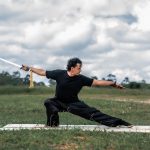In the world of combat sports, where success hinges on strength and resilience, the phrase 'tough as nails' takes on a literal meaning. For practitioners of Muay Thai and MMA, shin conditioning is a crucial element of training.
This ultimate guide aims to provide a comprehensive understanding of shin conditioning, exploring its benefits, techniques, recovery, and potential risks.
With step-by-step instructions and scientific insights, this article will equip aspiring martial artists with the knowledge and tools needed to master the art of shin conditioning.
Key Takeaways
- Shin conditioning is a crucial aspect of training in Muay Thai and MMA, as it enhances a fighter's performance and overall effectiveness in combat.
- Shin conditioning reduces the risk of fractures and increases pain tolerance, allowing for powerful strikes with less risk of injury.
- Techniques for shin conditioning include shin-to-shin conditioning, using Thai pads and Muay Thai banana bags, and shin taps with conditioning sticks.
- Proper recovery and maintenance, such as applying cold compress, rest, elevation of legs, proper nutrition, and supplementation, are crucial for maintaining effectiveness and longevity of shin conditioning.
Importance of Shin Conditioning
Shin conditioning is a crucial aspect of training in Muay Thai and MMA. It plays a vital role in enhancing the fighter's performance and overall effectiveness in combat. The shins are often used as weapons in striking techniques, such as kicks and knee strikes, making them vulnerable to injury if not properly conditioned.
By strengthening the shins through specific exercises and techniques, fighters can reduce the risk of fractures and increase their pain tolerance.
The importance of shin conditioning cannot be overstated. Well-conditioned shins not only allow fighters to deliver powerful strikes with less risk of injury, but they also enable them to absorb and block incoming strikes more effectively. This increased resilience can give fighters a significant advantage in the ring or cage.
Additionally, shin conditioning improves blood flow and bone density, which can enhance recovery time and prevent long-term damage.
Science Behind Shin Conditioning
The science behind shin conditioning lies in understanding the physiological processes that occur within the bones, muscles, and connective tissues when subjected to stress and repetitive impact. When the shins are conditioned, several benefits can be achieved.
Firstly, the bones remodel and adapt, becoming denser and stronger over time. Microfractures occur during the conditioning process, triggering an inflammatory response that leads to ossification and the formation of new bone tissue.
Collagen remodeling also takes place, enhancing the structural integrity of the connective tissues.
Additionally, the muscles hypertrophy, becoming more resilient to impact.
Finally, shin conditioning improves pain tolerance, allowing fighters to withstand powerful strikes without debilitating pain.
To prevent shin injuries, it is crucial to gradually increase the intensity and frequency of conditioning exercises, prioritize proper technique, use protective gear, and ensure adequate rest and recovery.
Techniques for Shin Conditioning
To effectively condition the shins for Muay Thai and MMA, a variety of techniques can be utilized to strengthen and toughen the bones, muscles, and connective tissues. Shin conditioning techniques focus on gradually increasing the density and resilience of the shins, allowing fighters to deliver powerful kicks without fear of injury.
Advanced shin conditioning exercises include:
- Shin-to-shin conditioning: Fighters repeatedly strike their shins against a partner's shins or a heavy bag to build tolerance to impact.
- Using Thai pads and Muay Thai banana bags: This helps practice striking with force and precision.
- Shin taps with conditioning sticks: This technique gradually increases the strength and durability of the shins.
It is important to note that these techniques should be approached with caution and gradually intensified to avoid excessive damage or injury.
Recovery and Maintenance
Proper recovery is crucial for maintaining the effectiveness and longevity of shin conditioning in Muay Thai and MMA. After intense shin conditioning sessions, it is important to implement recovery techniques to allow the shins to heal and adapt to the stress they have undergone.
One effective method is to apply a cold compress to reduce inflammation and swelling. Rest and elevation of the legs can also aid in the recovery process.
Additionally, proper nutrition plays a vital role in recovery. Consuming a well-balanced diet that includes protein, carbohydrates, and healthy fats will provide the necessary nutrients for tissue repair and growth.
Supplementation with collagen and vitamins such as vitamin C and D can further support the recovery of the shins.
Risks and Side Effects
After discussing the importance of proper recovery and maintenance for shin conditioning in Muay Thai and MMA, it is essential to address the potential risks and side effects associated with this training method.
While shin conditioning can provide numerous benefits for fighters, it is crucial to be aware of the potential long-term consequences and strategies for preventing injury.
Potential long-term consequences of shin conditioning include the risk of developing arthritis from repeated trauma to the shins. This can result in chronic pain and limited mobility in the affected joints. Additionally, the intense stress placed on the shins during conditioning can lead to microfractures, bruising, and swelling, which may require extended recovery time.
To minimize these risks, it is important to monitor training intensity and allow for adequate recovery time between sessions. Using proper padding and protective gear, such as shin guards, can also help mitigate the risk of injury. Additionally, implementing a well-rounded training program that includes strength and flexibility exercises can improve overall shin health and resilience.
Frequently Asked Questions
How Long Does It Take to See Results From Shin Conditioning?
The timeline for seeing results from shin conditioning varies depending on individual factors such as frequency and intensity of exercises. However, with consistent and effective shin conditioning exercises, one can expect improvements in shin strength and resilience within a few months of dedicated training.
Can Shin Conditioning Exercises Be Done Without Equipment?
Shin conditioning exercises can indeed be done without equipment. Bodyweight alternatives are effective for developing strength and resilience. Barefoot training can enhance proprioception and balance, ultimately impacting overall kicking power.
Is There a Specific Age or Experience Level Required for Shin Conditioning?
Age restrictions or experience level are not required for shin conditioning. It is a beginners' guide accessible to all. Shin conditioning is a vital aspect of training in Muay Thai and MMA, ensuring fighters develop strong and resilient shins.
Are There Any Alternative Methods or Supplements for Enhancing Shin Conditioning?
Alternative methods and natural remedies can enhance shin conditioning in Muay Thai and MMA. These may include techniques such as acupuncture, herbal remedies, and specific exercises targeting bone strength and collagen production.
Can Shin Conditioning Help Prevent Injuries in Other Parts of the Body, Such as the Knees or Ankles?
Shin conditioning can help prevent injuries in other parts of the body, such as the knees or ankles, by increasing the strength and resilience of the shin bones, which can absorb impacts and reduce the risk of trauma in adjacent areas.
Conclusion
In conclusion, shin conditioning is a fundamental aspect of training for Muay Thai and MMA practitioners. By following the science behind shin conditioning and utilizing various techniques, individuals can strengthen their shins and improve their performance in combat sports.
Proper recovery and maintenance are essential for preventing potential risks and side effects associated with shin conditioning. With dedication and the right approach, athletes can develop strong and resilient shins, enhancing their overall skill and success in the ring.
- 15 Best Martial Arts Weapons (Fighting & Training) - October 14, 2024
- Is Fencing a Martial Art? (Yes, 4 Reasons Why) - October 14, 2024
- 7 Best Martial Arts for Self-defense Ranked (Highly Effective) - October 14, 2024










